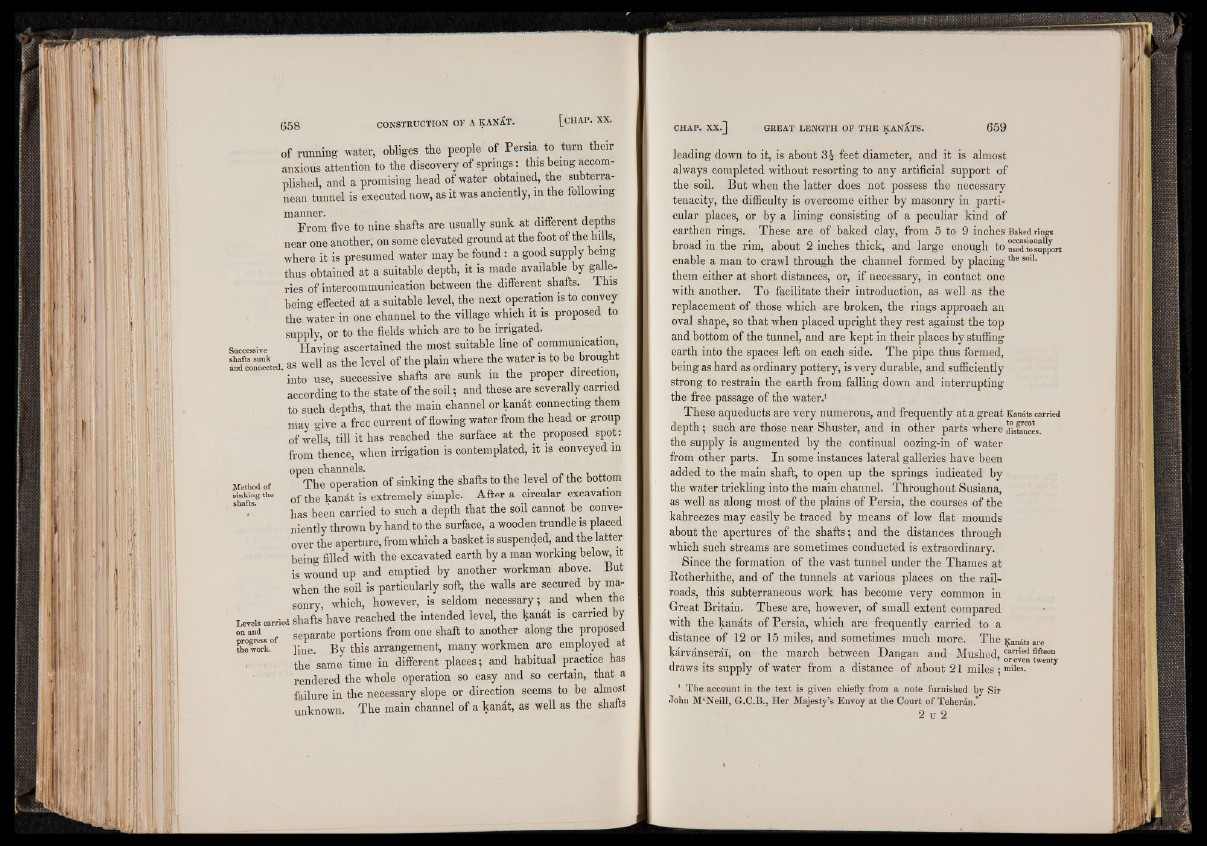
of running water, obliges the people of Persia to turn their
anxious attention to the discovery of springs: this being accomplished,
and a promising head of water obtained, the subterranean
tunnel is executed now, as it was anciently, in the following
manner. ,
From five to nine shafts are usually sunk at different depths
near one another, on some elevated ground at the foot of the hills,
where it is presumed water may be found: a good supply being
thus obtained at a suitable depth, it is made available by galleries
of intercommunication between the different shafts, lh is
being effected at a suitable level, the next operation is to convey
the-water in one channel to the village which it is proposed to
supply, or to the fields which are to be irrigated.
Successive Having ascertained the most suitable line of communication
aX o n n e c te d as well as the level of the plain where the water is to be brought
’ into use, successive shafts are sunk in the proper direction,
according to the state of the soil; and these are severally carried
to such depths, that the main channel or kanat connecting them
may give a free current of flowing water from the head or group
of wells, till it has reached the surface at the proposed spot:
from thence, when irrigation is contemplated, it is conveyed in
open channels. , „ ,
Method of The operation of sinking the shafts to the level of the bottom
sinking the kanat is extremely simple. After a circular excavation
has been carried to such a depth that the soil cannot be conveniently
thrown by hand to the surface, a wooden trundle is placed
over the aperture, from which a basket is suspended, and the latter
being filled with the excavated earth by a man working below, it
is wound up and emptied by another workman above. But
when the soil is particularly soft, the walls are secured by masonry,
which, however, is seldom necessary; and when the
Levels carried shafts have reached the intended level, the kanat is carried by
and f separate jC portions from — —---- one shaft to progress of
another along — the proposed
-
the work, line.
¡M By this arrangement, many workmen are employed at
the same time in different places; and habitual practice has
rendered the whole operation so easy and so certain, that a
failure in the necessary slope or direction seems to be almost
imVnnwn. The main channel of a kanat, as well as the shafts
leading down to it, is about 3£ feet diameter, and it is almost
always completed without resorting to any artificial support of
the soil. But when the latter does not possess the necessary
tenacity, the difficulty is overcome either by masonry in particular
places, or by a lining consisting of a peculiar kind of
earthen rings. These are of baked clay, from 5 to 9 inches Baked rings
broad in the rim, about 2 inches thick, and large enough to ¡S^tosupport
enable a man to crawl through the channel formed by placingthe s°l1-
them either at short distances, or, if necessary, in contact one
with another. To facilitate their introduction, as well as the
replacement of those which are broken, the rings approach an
oval shape, so that when placed upright they rest against the top
and bottom of the tunnel, and are kept in their places by stuffing
earth into the spaces left on each side. The pipe thus formed,
being as hard as ordinary pottery, is very durable, and sufficiently
strong to restrain the earth from falling down and interrupting
the free passage of the water.1
These aqueducts are very numerous, and frequently at a great Kanats carried
depth; such are those near Shuster, and in other parts where distances,
the supply is augmented by the continual oozing-in of water
from other parts. In some instances lateral galleries have been
added to the main shaft, to open up the springs indicated by
the water trickling into the main channel. Throughout Susiana,
as well as along most of the plains of Persia, the courses of the
kahreezes may easily be traced by means of low flat mounds
about the apertures of the shafts; and the distances through
which such streams are sometimes conducted is extraordinary.
Since the formation of the vast tunnel under the Thames at
Rotherhithe, and of the tunnels at various places on the railroads,
this subterraneous work bas become very common in
Great Britain. These are, however, of small extent compared
with the kanats of Persia, which are frequently carried to a
distance of 12 or 15 miles, and sometimes much more. The Kanats are
karvanserai, on the march between Danean and Mushed.carr!el1 fifleen j . i n t n or even twenty draws its supply of water from a distance of about 21 miles ;miles-
1 The account in the text is given chiefly from a note furnished by Sir
John M‘Neill, G.C.B., Her Majesty’s Envoy at the Court of T eheran*
2 u 2